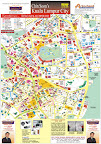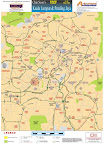Malaysia, An Attractive Asian Property Market
A featured article on Smart Investor Magazine, July 2011 Issue, now available at newsstands. For the full version, please get your copy now!
Highly Attractive
City Centres, mega projects and tourism areas are poised to become investment hotspots in Malaysia, aided by resilient Asia's booming growth.
Asia is experiencing a booming economic growth, and the region's resilience is evident even as global trade collapsed, developing Asia continued to grow. The rapid growths of both China and India continues to lift both regional and global trades, and this augurs well for the regional property market.
From an Asian perspective, it is safe to rank Malaysia as one of the most attractive property markets, with moderate to good gross rental yields of 6.93%, relatively low transaction costs and economic reforms that will improve the rental market.
The latest Asian Development Outlook 2011 report by the Asian Development Bank forecasted Malaysia, which recorded a gross domestic product (GDP) growth of 7.2% in 2010, to grow by 5.3% for 2011 and 2012.
Factors such as low inflation, high economic growth, low property prices, and potential for high capital gains have also helped to position the country as an attractive real estate investment destination for international investors.
In terms of price, Malaysian property prices are also the second lowest in Asia; a marked difference in prices compared to neighbouring Singapore where properties are at least 10 times more expensive and are recognised as one of the dearest in Asia.
In comparison, take the example of The Troika, a high-end condominium in the vicinity of KLCC that was designed by British firm Foster & Partners. Its for sale and/or rental price would probably cost five or six times more if it were located in more mature markets like London, New York and Paris.
Strong Potential
The biggest driver for the Malaysian property sector going forward will definitely be the Greater Kuala Lumpur initiative. Close to 10 million people, compared to 5.7 million in 2010, are expected to work, live, learn and play in this proposed thriving megalopolis by 2020.
The rejuvenation of the city, construction of a pedestrian network, extension of the Light Rail Transit, building of the Mass Rapid Transit system, KL International Financial District, and 100-storey Warisan Merdeka landmark, are just some of the projects that will make up the Greater KL conurbation, which has drawn international interest and investments.
Regional neighbours like Singapore, Hong Kong, Taiwan and mainland China have also begun to tighten regulations for property transactions, such as tighter monetary policies, the raising of downpayments, banning third home purchases and price control targets amongst others, to rein in runaway prices. This presents opportunities for foreign investment to flow into Malaysia.
Given this scenario, do we, as investors, have properties with quality and yields that match the best in the region, if not the world? London is one of the world's largest financial centres and there are more overseas banks in London than in any other international city. London is, truly, a global city.
KL is not yet London's equal but it has several examples of high-quality housing stock at relatively affordable prices that can contribute to the industry's global competitiveness.
Just like in London, the hunting grounds for wealthy families in KL are well-established residential areas that are characterised by wide roads and plenty of parks or trees, such as Bukit Tunku, Ampang Hilir, Bangsar and Damansara Heights.
These affluent neighbourhoods are the equivalent of London's Belgravia, Holland Park, Regent's Park, Chelsea and Mayfair, while new, well-planned townships - like Desa Park City - may someday become the equivalent of Chiswick in West London.
Challenges and Opportunities
In our opinion, the next 10 years will be the golden era for property investment in Malaysia. However, the market is no longer as it was in the past. It is changing fast and has become more commercialised, globalised and professional and I predict that, before 2020, the real estate market would have matured and hit peaking point.
A minority of the population will own the majority of the properties in city centres or other prime areas, resulting in more people renting a house in those areas. But not all properties will be beneficiaries of this growth. With the exception of economic growth and tourism areas, some properties are seeing an excess of supply and are overpriced in certain locations.
The best investment hotspots will be located at city centres, mega projects and tourism areas. Greater KL's landscape is expected to change with several major developments such as the high-speed rail from Singapore to Greater Kuala Lumpur, and eventually to China.
Capital inflows from foreign investors will also boost economic growth and encourage Malaysia to be more open to foreign investors and, of course, maintain our position as the best destination for real estate investment. And the best investment hotspots? City centres, mega projects and tourism areas.
As Malaysia works to increase its attractiveness as a tourist destination, the economic benefits from a thriving tourism industry will contribute to the value of tourism-related properties and this particular development is expected to make tourism-related local properties the most expensive by 2018.

 3:22 AM
3:22 AM
 水兴浪 Gavin Tee
,
水兴浪 Gavin Tee
,








0 Response to "Malaysia, An Attractive Asian Property Market"
Post a Comment